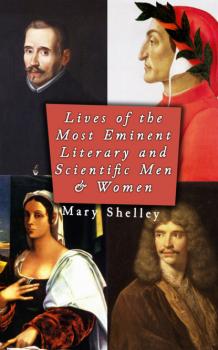ТОП просматриваемых книг сайта:















Mary Shelley
Список книг автора Mary ShelleyАннотация
First published in 1826, The Last Man is an apocalyptic sci-ence fiction work by Mary Shelley. A courtly society at the crossroads between monarchy and republic is afflicted by a serious epidemic that threatens the survival of all mankind. Will Lionel be able to save the few who are faithful to him? In addition to an exciting novel, Shelley also succeeds in in-terweaving autobiographical, historical and scientific aspects into the story.
Аннотация
This five-volume work consists in biographies of the most important writers and thinkers of their time, since 14th until 19th century. Most of them were written by the Romantic writer Mary Shelley. Her extensive knowledge of history and languages, her ability to tell a gripping biographical narrative, and her interest in the burgeoning field of feminist historiography are reflected in these works. She wrote in a style that combined secondary sources, memoir, anecdote, and her own opinions. Her political views are most obvious in the Italian Lives, where she supports the Italian independence movement and promotes republicanism; in the French Lives she portrays women sympathetically, explaining their political and social restrictions and arguing that women can be productive members of society if given the proper educational and social opportunities. Contents: Vol. 1: Lives of the most eminent literary and scientific men of France (Part. I): Montaigne Rabelais Corneille Rochefoucauld Molière La Fontaine Pascal Madame de Sévigné Boileau Racine Fénélon Vol. 2: Lives of the most eminent literary and scientific men of France (Part. II): Voltaire Rousseau Condorcet Mirabeau Madame Roland Madame de Staël. Vol. 3: Lives of the Most Eminent Literary and Scientific Men of Italy, Spain and Portugal (Part. I): Dante Petrarch Boccaccio Lorenzo de' Medici, &c. Bojardo Berni Ariosto Machiavelli Vol. 4: Lives of the Most Eminent Literary and Scientific Men of Italy, Spain and Portugal (Part. II): Galileo Guicciardini Vittoria Colonna Guarini Tasso Chiabrera Tassoni Marini Filicaja Metastasio Goldoni Alfieri Monti Ugo Foscolo Vol. 5: Lives of the Most Eminent Literary and Scientific Men of Italy, Spain and Portugal (Part. III): Boscan Garcilaso de la Vega Diego Hurtado de Mendoza Luis de Leon Herrera Saa de Miranda Jorge de Montemayor Castillejo The early dramatists Ercilla Cervantes Lope de Vega Vicente Espinel; Esteban de Villegas Gongora Quevedo Calderon Early poets of Portugal Camoens
Аннотация
"I started from my sleep with horror; a cold dew covered my forehead, my teeth chattered, and every limb became convulsed; when, by the dim and yellow light of the moon, as it forced its way through the window shutters, I beheld the wretch—the miserable monster whom I had created. He held up the curtain of the bed; and his eyes, if eyes they may be called, were fixed on me. His jaws opened, and he muttered some inarticulate sounds, while a grin wrinkled his cheeks. He might have spoken, but I did not hear; one hand was stretched out, seemingly to detain me, but I escaped and rushed downstairs. I took refuge in the courtyard belonging to the house which I inhabited, where I remained during the rest of the night, walking up and down in the greatest agitation, listening attentively, catching and fearing each sound as if it were to announce the approach of the demoniacal corpse to which I had so miserably given life."
"Frankenstein" by Mary Shelley was first published in 1818. The bestselling novel about the monster created by scientist Victor Frankenstein has had a considerable influence in literature and popular culture and spawned a complete genre of horror stories, films and plays.
"Frankenstein" by Mary Shelley was first published in 1818. The bestselling novel about the monster created by scientist Victor Frankenstein has had a considerable influence in literature and popular culture and spawned a complete genre of horror stories, films and plays.
Аннотация
Para Mary Shelley, los monstruos no son aquellos cuentos de hadas desde el principio de los siglos esos que se esconden debajo de la cama o en un closet; no, para la autora los monstruos son aquellas personas con las que podemos llevar una relación cercana, alguien que ha sembrado odio y rencor en su ser, en los otros, y que actúa con violencia, con una predominante necesidad de lastimar: Con esta premisa, Mary Shelley nos presenta una recopilación de cuentos donde el hombre es capaz de actuar de manera atroz con tal de conseguir lo que quiere, cuentos donde podemos ver la forma más cruda de este ser al que llamamos humano.










